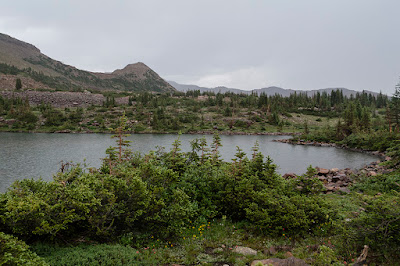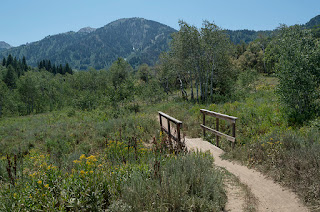The Trail
This difficult trail is about 16.5 miles when done all at once. However, when done as a backpacking trip as we did with Jordan Lake as a base camp, you can expect to hike about 18.1 miles round trip with about an 1100 ft. elevation change. Keep in mind that there is a good amount of up and down on this trail, so your total climb will end up being more than this. Also, note that the loop around the basin does not follow a trail. While many people do it and there are even campsites along the way, it is more of a loose route that you must navigate on your own (which adds some to the difficulty of the trail).
 |
Topographical Map
|
 |
Topographical Map - Basin Only
|
 |
Graph of Elevation
|
 |
Trail in Google Earth
|
This trail starts from the Highline Trailhead and starts with a steady descent toward Scudder Lake. After 0.8 mile in, there is a trail split. To head to Naturalist Basin, stay left here; going right will lead to Mirror Lake.
 |
Turn-off for Mirror Lake
|
The trail continues to descend almost all the way to Scudder Lake, which is about 2 miles in from the trailhead. The area at Scudder Lake about to the Packard Lake turn-off is burned from a fire in 2018. (This area is marked on the map with the fire symbols.)
 |
Scudder Lake with Murdock Mountain in the background
|
 |
Looking out toward the direction of Hayden Peak from the trail
|
 |
Turn-off for Packard Lake
|
About 4.3 miles into the hike, you will reach another split. Heading right here will take you to the
Four Lakes Basin. Go left to reach the Naturalist Basin.
The trail grows increasingly rocky as it nears Naturalist Basin. There are plenty of muddy and wet areas along the way too. One area does have old boardwalks along the trail. There are also a number of places that downed trees have blocked the original trail, and makeshift paths have been formed around these obstructions. These spots become more common the further out from the trailhead you get.
In about another 1.1 miles from the Four Lakes Basin split, you will reach the split to head either toward Blue Lake or Jordan Lake. We had decided to camp at Jordan Lake, so we went right here, which went across the creek. The path on the other side may be dry at certain times, but the rock lined path was flooded when we did this hike.
 |
Crossing the creek
|
There are a couple other smaller lakes on the way to Jordan Lake, and we did find a couple people camped at Evermann Lake. However, there a lot more place to camp around Jordan Lake. There is a path that crosses the creek and heads to the west side of Jordan Lake with campsites along it, and there are also campsites along the south side.
 |
Jordan Lake with Mount Agassiz in the background
|
The next morning we continued to circle Naturalist Basin, heading in a counterclockwise loop toward Shaler Lake. This loop by itself was about 5.2 miles long. The trail continues clearly along the shores of Jordan Lake and up to the rocky ledge that surrounds much of the lake. However, at that point the trail disappeared entirely and we were left to navigate our own route. As long as you are good with a map, compass, and/or GPS, finding a suitable route around the basin isn't too difficult. Following the more obvious paths that appeared less rocky, less steep, and more open lead us around quite smoothly.
 |
The trail disappears after rounding this rocky ledge
|
By continuing northeast across the meadow, you will reach Shaler Lake. There are some campsites here, but the area is much more exposed that Jordan Lake.



From Shaler Lake we ended up heading north since we saw rock cairns that direction. We realized after awhile though that we were headed the wrong direction, so we turned around. Perhaps the cairns were placed by those headed to Spread Eagle Peak, for which some people may head up this direction. We should have cut to the west, as shown in blue in the topographical map. Going this direction, the way to Faxon Lake is pretty short and smooth crossing meadows.
Heading to the north end of Faxon Lake along the boulders there gives a nice view of the lake. This is also another route often followed to reach Spread Eagle Peak, heading around the rocky outcrop and then up the steep slope to the ridgeline.
 |
Faxon Lake
|
 |
Head along the boulders lining the lake shore and around the
rocky ledge to head to Spread Eagle Peak
|
Faxon Lake is a long lake; we headed down its east side and then veered more south to go around the higher hill to the west that also seemed rockier. We came along another campsite among the trees this way shortly after Faxon Lake.
 |
Faxon Lake from south side
|
After heading downhill for a ways we turned west and soon started to see small unnamed lakes amid fields of wildflowers capped with distant mountain ridges.

The next large lake is LeConte Lake.
 |
LeConte Lake
|
As we came to these last few lakes, a pretty heavy thunderstorm hit us and pelleted us with rain, and then with chunks of hail. Luckily we were able to find some decent cover in the trees, but we were also feeling anxious to finish the hike and get back without further interference from storms. It continued to rain more lightly as we continued around to the rest of the lakes, but we didn't feel like hiking any closer than we did to the next lake, Walcott Lake.
 |
Walcott Lake
|
As we approached the west side of Walcott Lake, we hit a dense field of large boulders (marked by the green dot on the topographical map). We aimed to avoid these as much as possible by turning more to the south.
 |
Boulder field by Walcott Lake
|
We did avoid the large rocks this way, and we also found a relatively easy path through the dense brush that followed the boulders. After getting through this, we arrived at Blue Lake.
 |
Approaching Blue Lake with Mount Agassiz behind it
|
 |
Blue Lake
|
We thought the trail would pick up at Blue Lake, but we couldn't find any real sign of a trail. We headed down between the two smaller lakes to the south and found the trail at the end of those. From here, the trail descended sharply along the side of the waterfall to the Morat Lakes.
 |
West Morat Lake (rain drops kept getting on my camera lens)
|
 |
East Morat Lake
|
 |
Waterfall along the trail
|
The trail passes between East and West Morat Lakes and continues on. There are a number of campsites along the shores of these lakes.
 |
West Morat Lake
|
The trail continues to descend at a good rate through more wet and marshy areas to the split for Jordan/Blue Lakes. Because our base camp was at Jordan Lake, we continued around the loop back to our camp there. Going back to Jordan Lake and then returning to this junction again the next day added a couple miles to our overall trip. We then hiked back to the Highline Trailhead the following day.
This trail is open to livestock and dogs. Dogs are supposed to be leashed, and you must clean up and pack out after your dog. There are vault toilets at the trailhead.
Directions
This trail is located near Kamas, Utah. It is found in Duchesne County
in the high Uinta mountains between the Mirror Lake and Crystal Lake
areas. To get there from the Salt Lake area, take I-80 to Exit 146 for
Heber. From there head south on UT-189 and take Exit 4 toward Kamas
traveling east on UT-248. Once in Kamas, turn left onto Main Street,
then take a right onto Center St./UT-150. Continue on this road for 34 miles until you arrive at the Highline Trail parking area, which will be on your right. GPS Coordinates: N40° 43.327' W110° 51.850'























































